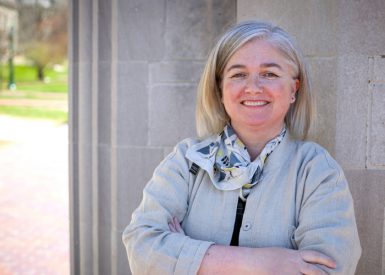Journalism faculty provide tips for safely covering COVID-19
The most experienced war correspondent Elaine Monaghan ever knew was Kurt Schork. The reporter, who covered conflicts and wars in the Balkans, Iraq, Chechnya, Iraqi Kurdistan, Sri Lanka and East Timor, was killed in Sierra Leone in 2000. He took great risks, Monaghan said, but he also always wore a seatbelt in the car.

Reporting in dangerous situations takes careful planning and preparation for anything that might happen.
“No story is worth someone’s life,” said Monaghan, a professor of practice in The Media School who has covered wars and disasters, including the Kosovo conflict.
As Media School students report during an unprecedented global health crisis, journalism faculty shared safety advice to ensure reporters keep themselves and their communities safe and informed.
Jim Kelly, associate professor and director of journalism, advised students to seek new means of reporting that comply with Centers for Disease Control guidelines. For now, that means practicing responsible social distancing by avoiding physical contact and maintaining a distance of at least 6 feet from other people.
“Restrict your information gathering to online methods of both research and query,” he said.
The options to do so are plentiful: Reporters can take advantage of resources like Facebook, Zoom, WhatsApp, FaceTime, Marco Polo and more to speak to sources without physical contact.

“There seems to be kind of a proliferation of knowledge about how we can communicate with one another without face-to-face interpersonal communication,” Kelly said.
But it’s also important to emphasize safe practices and guidelines that allow students to report in-person, too. In collaborating on a statement outlining the policies for The Media School’s journalism unit during the coronavirus pandemic, Kelly and other faculty specified that students reporting on events in person and in real-time must follow CDC guidelines as they evolve throughout the pandemic.
“We did not want to completely preclude student observation of events, or even student interaction with people in real time,” he said.
Kelly has taken students to East Africa seven times to cover the HIV epidemic and efforts to mitigate it. The preparation and advice he gives to student reporters, and how it differs from the policies and guidelines in place for students during the COVID-19 pandemic, have been on his mind recently.
As they prepare to cover the epidemic, students in the Reporting HIV/AIDS in Africa course learn extensively about the pathology of the virus and the nature of the epidemic. The safety guidelines Kelly gives them are largely reassurance that HIV is difficult to transmit and contract outside of specific circumstances. The risks of interacting with HIV-positive individuals for reporting purposes are ostensibly nonexistent.
With COVID-19, that’s not the case. But Kelly maintains that the best means of preparation is staying informed and adhering to public safety guidelines.
“We don’t have nearly that level of understanding of the coronavirus, but the lesson is still the same,” he said. “You can only act responsibly as a journalist if you are as completely informed by expert knowledge as you possibly can.”

Professor of practice Joseph Coleman, who covered conflict and natural disasters as a foreign correspondent in Latin America, the Middle East and Asia, advised students to consult the resources and guidelines available to them, and to understand that the preparation and safety measures necessary differ based on the situation.
“It really depends on how invasive you want to go and how close you want to get to places where you’re going to be more vulnerable to the virus,” he said.
Reporting on the scene at a grocery store as people stock up on supplies amidst the pandemic requires a different level of preparedness than going into a hospital where coronavirus patients are being treated, he said.
Coleman cited the Committee to Protect Journalists’ Coronavirus Safety Advisory as a valuable and regularly updated safety resource.
He recommended safety practices such as frequent handwashing, using gloves and face masks, and decontamination of any reporting equipment.
Reporters at large publications are more likely to have access to training and proper equipment, Coleman said. But for students reporting during the crisis, access to such safety measures might be limited.
“Putting yourself in harm’s way is not the best way of getting the story,” he said.
And beyond personal safety measures, it’s important for reporters to understand the pandemic as a public health concern with risks for themselves and their communities.
“We need journalists to go out and tell the story in the best way possible,” Coleman said. “And that might involve getting very close to the action, but if you do something like that, then you’ve got to take the precautions afterward, like self-quarantining.”
Monaghan emphasized the potential psychological toll of experiencing and covering a global crisis like the COVID-19 outbreak.
“Stay informed, as a journalist and a human being, because you’re a human being first,” she said.
She advised reporters to consult the Dart Center for Journalism and Trauma as a resource on ensuring personal and public safety, as well as coping with the daily stress of covering a pandemic.
And in writing stories, Monaghan said it’s important that reporters focus on the way they’re crafting their coverage and writing about the disease. There’s no need to exaggerate or over-complicate the story, she said. People don’t need to be told the disease is “brutal” or “deadly”; they need to know what it does to them.
“This is not a time for colorful prose,” she said.
But it is a time for clarity and precision. As publications across the globe push out more and more information about the pandemic every day, it’s important that reporters focus on writing stories that are simple and informative. In the midst of a worldwide crisis, countless people turn to journalists for information.
Monaghan emphasized the importance and effectiveness of graphics in COVID-19 coverage, to communicate lots of information as simply and quickly as possible. And she also urged reporters to tell people what they can do to protect themselves and their communities.
“In that way journalism can be part of the solution to this horrible situation that we find ourselves in,” she said.

